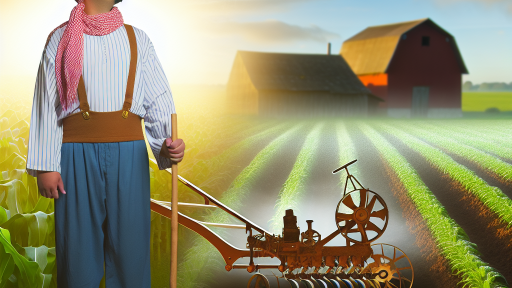Understanding Crop Insurance for Farmers
Definition of Crop Insurance
Crop insurance protects farmers from financial loss.
It covers damage to crops due to various risks.
These risks include weather events, pests, and diseases.
Farmers can choose from several insurance options.
This flexibility allows them to tailor coverage to their needs.
Importance of Crop Insurance
Crop insurance plays a crucial role in farming stability.
It offers protection against unpredictable factors.
Farmers without insurance risk financial ruin after disasters.
Insurance helps sustainable farming practices thrive.
Additionally, it encourages investments in new technologies.
Types of Crop Insurance
Farmers can choose from multiple types of crop insurance.
Actual Production History (APH) Insurance is one option.
This type is based on the farm’s production history.
Revenue Insurance is another choice available to farmers.
It protects against revenue loss from low prices or yields.
Transform Your Agribusiness
Unlock your farm's potential with expert advice tailored to your needs. Get actionable steps that drive real results.
Get StartedHow Crop Insurance Works
Farmers pay premiums based on their selected coverage.
When a loss occurs, they file a claim.
An adjuster assesses the damage and all relevant details.
Claims can take time to process based on various factors.
Ultimately, the payout helps farmers recover financially.
Government Support and Incentives
The government supports crop insurance through subsidies.
These subsidies lower premiums for participating farmers.
Various programs promote crop insurance awareness and enrollment.
Farmers can access resources for choosing the right plan.
These programs aim to stabilize the agricultural economy.
Types of Crop Insurance: Federal vs. Private Options
Overview of Crop Insurance
Crop insurance protects farmers from financial losses.
This type of insurance helps mitigate the risks associated with farming.
Farmers can choose between federal and private insurance options.
Understanding these options is vital for making informed decisions.
Federal Crop Insurance
Federal crop insurance is primarily offered through the Risk Management Agency (RMA).
This insurance program provides standardized policies to farmers.
For example, the Actual Production History (APH) policy is common.
It covers losses due to natural disasters and crop failure.
Farmers must purchase this insurance before the planting season.
RMA subsidizes premiums to make them more affordable for farmers.
This support encourages participation in crop insurance programs.
Types of Federal Policies
Farmers can choose from various federal crop insurance policies.
Major policies include:
- Revenue Protection (RP) policy
- Yield Protection (YP) policy
- Catastrophic (CAT) insurance
Each policy has unique features and benefits.
Showcase Your Farming Business
Publish your professional farming services profile on our blog for a one-time fee of $200 and reach a dedicated audience of farmers and agribusiness owners.
Publish Your ProfileFarmers should evaluate their specific needs and risks.
Private Crop Insurance
Private crop insurance offers additional options not covered by federal programs.
Farmers can customize policies to better suit their needs.
This insurance is provided by various private companies.
For instance, companies like AgriSure and NAU Country Insurance offer tailored solutions.
Private crop insurance often complements federal policies.
This combination can provide broader coverage.
Advantages of Private Insurance
Private insurance can offer quicker claims processing compared to federal options.
Additionally, it often includes specialized coverages.
Farmers can also select higher coverage levels.
This flexibility allows for better risk management strategies.
Choosing the Right Insurance
Selecting the right insurance involves careful consideration.
Farmers should assess their risk profiles and operational needs.
Evaluating both federal and private options is crucial.
Ultimately, the chosen policies should align with the farmer’s financial goals.
Consulting with insurance agents can provide additional guidance.
Understanding Risk Management
How Crop Insurance Protects Farmers
Farmers face several risks in their daily operations.
Weather events like droughts and floods can devastate crops.
Pests and diseases also threaten agricultural productivity.
Crop insurance provides a safety net against these uncertainties.
It helps farmers recover financially after a loss.
Moreover, it promotes sustainable farming practices.
The Basics of Crop Insurance
Crop insurance policies generally fall into two categories: multiple peril and crop revenue insurance.
Multiple peril insurance covers losses due to various risks like adverse weather.
In contrast, crop revenue insurance protects against revenue losses.
This helps farmers focus on their fields instead of financial worries.
Farmers can choose policies that suit their needs and risk tolerance.
Benefits of Crop Insurance
Most importantly, crop insurance stabilizes farmers’ incomes.
It helps farmers maintain cash flow during tough times.
Consequently, they can invest in future crop cycles and improvements.
Besides economic stability, crop insurance encourages innovation.
Farmers are more likely to try new crops or methods when insured.
Challenges Faced by Farmers
Despite its benefits, crop insurance has challenges.
Policy costs can be high, putting a strain on budgets.
Additionally, understanding the terms can be complex.
Farmers may struggle to select the best coverage options.
Therefore, education and resources are critical for effective decision-making.
Future of Crop Insurance
The future of crop insurance looks promising as technology advances.
Innovations in data collection can improve risk assessment.
For instance, satellite imagery and climate modeling can enhance predictions.
Showcase Your Farming Business
Publish your professional farming services profile on our blog for a one-time fee of $200 and reach a dedicated audience of farmers and agribusiness owners.
Publish Your ProfileSuch advancements may lead to more accurate pricing and tailored policies.
Ultimately, this progress will benefit farmers across the nation.
See Related Content: Insurance Trends Impacting Modern Agribusiness
Understanding Crop Insurance for Farmers
Key Terms and Concepts
Crop insurance protects farmers against loss of income due to reduced crop yields.
Understanding key terms helps farmers make informed decisions.
Coverage
Coverage refers to the types of risks that the insurance will protect against.
It typically includes coverage for natural disasters, pests, and disease.
Farmers can choose a coverage level based on their risk tolerance.
Higher coverage often results in higher premium costs.
Types of Coverage
Multiple Peril Crop Insurance (MPCI) covers various risks in one policy.
Crop Revenue Coverage (CRC) protects against loss of revenue.
Actual Production History (APH) calculates insurance based on historical yields.
Each type has distinct benefits and limitations.
Premiums
Premiums are the amounts farmers pay for their insurance coverage.
They depend on the type of coverage, the crop, and the farm’s location.
Farmers can often receive subsidies to help reduce their premium costs.
Understanding how premiums work can help with budgeting for insurance expenses.
Factors Affecting Premiums
Crop type significantly impacts insurance premiums.
Higher-risk crops typically have higher premiums.
Location and climatic conditions also influence pricing.
Additionally, farmers with a history of claims may face higher premiums.
Deductibles
Deductibles are the out-of-pocket costs that farmers must pay before insurance coverage kicks in.
Higher deductibles usually lead to lower premiums.
Farmers must carefully assess their financial situations when selecting deductibles.
Understanding deductibles can impact overall financial strategy in farming.
Choosing the Right Deductible
Farmers should consider their financial capacity when choosing deductibles.
A low deductible may offer more immediate coverage but at a higher cost.
Conversely, a high deductible can save money on premiums long-term.
Striking the right balance is crucial for effective risk management.
You Might Also Like: Effective Marketing Strategies for International Farms
The Application Process: Steps to Obtain Crop Insurance
Gather Necessary Documentation
Before starting the application, collect all relevant documents.
Gather records of previous crops and yields.
Include financial records for the last few years.
Furthermore, obtain any necessary farm maps and diagrams.
Choose the Type of Crop Insurance
Understand the different types of crop insurance available.
Consider options such as Actual Production History (APH) or Revenue Protection.
Compare benefits of each type carefully.
Also, think about your specific farming needs and risks.
Contact an Insurance Agent
Finding a qualified crop insurance agent is crucial.
Search for agents with experience in your area.
Showcase Your Farming Business
Publish your professional farming services profile on our blog for a one-time fee of $200 and reach a dedicated audience of farmers and agribusiness owners.
Publish Your ProfileThe agent can guide you through the options and details.
Additionally, they can help with any questions about policies.
Complete the Application Form
Fill out the application form accurately and completely.
Provide all requested information about your farm and crops.
Pay attention to the deadlines for submission.
Moreover, ensure that all fields are filled out correctly.
Review Policy Options and Premium Costs
After submitting your application, review the policy options provided.
Examine the premium costs associated with each option.
Take your time understanding the coverage details.
Also, consider the payment plans available for premiums.
Sign and Submit the Final Documentation
Once you select a policy, review the final documents.
Ensure all information is accurate before signing.
Submit the signed documentation as instructed by your agent.
Finally, keep a copy for your records.
Learn More: Balancing Family and Business in Farm Succession

Claims Process: How to File and What to Expect
Understanding the Claims Process
The claims process is a crucial part of crop insurance for farmers.
It allows farmers to receive compensation for losses.
Understanding how to file a claim and what to expect is essential.
Steps to File a Claim
Start by notifying your insurance provider promptly.
Provide them with detailed information about the damage.
Document losses thoroughly using photos and records.
Submit a formal claim form to your provider.
Keep copies of everything for your records.
What to Expect After Filing
After submitting your claim, an adjuster will be assigned.
The adjuster will assess your damages in person.
They will determine the extent of your losses.
This process may take some time, so be patient.
Potential Outcomes
Once the assessment is complete, you will receive a decision.
Your insurance provider will communicate the outcome to you.
If approved, you will receive compensation for your losses.
If denied, you may appeal the decision with additional evidence.
Common Mistakes to Avoid
One common mistake is delaying the notification of loss.
Ensure you report losses as soon as possible.
Another mistake is incomplete documentation of damages.
Make sure you gather all necessary evidence before filing.
In addition, understand your policy to avoid surprises.
Helpful Tips for Success
Maintain a good relationship with your insurance provider.
Consult with other farmers who have filed claims.
Stay organized throughout the process to ensure efficiency.
Finally, review your policy regularly for any changes.
Showcase Your Farming Business
Publish your professional farming services profile on our blog for a one-time fee of $200 and reach a dedicated audience of farmers and agribusiness owners.
Publish Your ProfileLearn More: Enhancing Farm Success Through Strategic Partnerships
Common Misconceptions About Crop Insurance
Understanding the Basics
Crop insurance plays a vital role in farming operations.
Many farmers view it as an unnecessary expense.
However, it provides essential financial protection.
This protection safeguards against unpredictable weather events.
Additionally, it can cover losses from pests and diseases.
Myth: Crop Insurance is Only for Large Farms
Some believe that only large farms benefit from crop insurance.
In fact, crop insurance is available for farms of all sizes.
Small farms can also face significant losses.
Therefore, they need protection to sustain their operations.
Moreover, insurance options cater specifically to small farmers.
Myth: Crop Insurance Covers All Losses
Another common misconception is that crop insurance covers everything.
While it offers significant coverage, exclusions exist.
For example, it may not cover losses due to negligence.
Farmers should thoroughly understand their policies.
Thus, they can be aware of coverage limits and exclusions.
Myth: Claims Are Difficult to File
A common belief is that filing claims is a complicated process.
Fortunately, many insurance companies streamline this procedure.
Farmers can often file claims online or via simple forms.
Furthermore, insurance agents provide assistance and guidance.
Effective communication can ease the claims process significantly.
Myth: Insurance Premiums Are Too High
Many farmers think crop insurance premiums are unaffordable.
However, costs vary based on coverage levels and types.
Subsidies often reduce premiums for participating farmers.
Additionally, the financial security of crop insurance far outweighs its cost.
Investing in crop insurance can ultimately save a farm’s future.
Educating Farmers About Their Options
Education plays a crucial role in dispelling these myths.
Farmers should seek information from reputable sources.
Organizations like the USDA offer valuable resources.
Networking with other farmers also helps share experiences.
Informed decisions lead to better protection strategies.
Future Trends in Crop Insurance: Innovations and Challenges Ahead
Technological Innovations in Crop Insurance
Technology is revolutionizing crop insurance practices.
Farmers are increasingly using precision agriculture tools.
Drones and satellite imagery provide real-time data.
This data helps assess risks and determine coverage levels.
Additionally, machine learning models enhance predictive accuracy.
These innovations reduce costs for both insurers and farmers.
Personalized Insurance Products
Insurance companies focus on creating customized products.
Farmers have diverse needs based on their specific crops.
Therefore, personalized insurance plans cater to individual circumstances.
Showcase Your Farming Business
Publish your professional farming services profile on our blog for a one-time fee of $200 and reach a dedicated audience of farmers and agribusiness owners.
Publish Your ProfileThis approach improves access and relevance of coverage.
Moreover, customers experience better satisfaction rates.
Data Security and Privacy Concerns
As more data is collected, security becomes paramount.
Farmers worry about potential breaches of sensitive information.
Insurance companies must implement robust security measures.
Additionally, regulations around data privacy are evolving.
Farmers should stay informed about their rights regarding data use.
Regulatory Challenges
Changing regulations impact insurance offerings.
Farmers need to navigate complex legislative environments.
Insurance providers adjust their policies based on regulatory shifts.
This can lead to gaps in coverage or unexpected costs.
Staying compliant is crucial for both parties involved.
The Impact of Climate Change
Climate change continues to influence agricultural practices.
Extreme weather events increase the need for insurance coverage.
Farmers face higher risks due to unpredictable weather patterns.
This trend forces insurers to adjust their risk models.
Ultimately, adapting to climate change is essential for future viability.
Additional Resources
Climate Change Adaptation: U.S. Department of Agriculture
Crop Insurance: Update on Opportunities to Reduce Program Costs …




